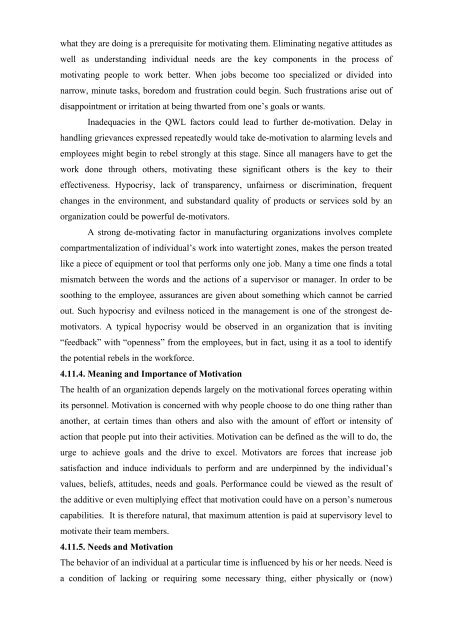UNIT – I Lesson 1 HRM – AN OVERVIEW Lesson Outline Nature of ...
UNIT – I Lesson 1 HRM – AN OVERVIEW Lesson Outline Nature of ...
UNIT – I Lesson 1 HRM – AN OVERVIEW Lesson Outline Nature of ...
You also want an ePaper? Increase the reach of your titles
YUMPU automatically turns print PDFs into web optimized ePapers that Google loves.
what they are doing is a prerequisite for motivating them. Eliminating negative attitudes as<br />
well as understanding individual needs are the key components in the process <strong>of</strong><br />
motivating people to work better. When jobs become too specialized or divided into<br />
narrow, minute tasks, boredom and frustration could begin. Such frustrations arise out <strong>of</strong><br />
disappointment or irritation at being thwarted from one’s goals or wants.<br />
Inadequacies in the QWL factors could lead to further de-motivation. Delay in<br />
handling grievances expressed repeatedly would take de-motivation to alarming levels and<br />
employees might begin to rebel strongly at this stage. Since all managers have to get the<br />
work done through others, motivating these significant others is the key to their<br />
effectiveness. Hypocrisy, lack <strong>of</strong> transparency, unfairness or discrimination, frequent<br />
changes in the environment, and substandard quality <strong>of</strong> products or services sold by an<br />
organization could be powerful de-motivators.<br />
A strong de-motivating factor in manufacturing organizations involves complete<br />
compartmentalization <strong>of</strong> individual’s work into watertight zones, makes the person treated<br />
like a piece <strong>of</strong> equipment or tool that performs only one job. Many a time one finds a total<br />
mismatch between the words and the actions <strong>of</strong> a supervisor or manager. In order to be<br />
soothing to the employee, assurances are given about something which cannot be carried<br />
out. Such hypocrisy and evilness noticed in the management is one <strong>of</strong> the strongest demotivators.<br />
A typical hypocrisy would be observed in an organization that is inviting<br />
“feedback” with “openness” from the employees, but in fact, using it as a tool to identify<br />
the potential rebels in the workforce.<br />
4.11.4. Meaning and Importance <strong>of</strong> Motivation<br />
The health <strong>of</strong> an organization depends largely on the motivational forces operating within<br />
its personnel. Motivation is concerned with why people choose to do one thing rather than<br />
another, at certain times than others and also with the amount <strong>of</strong> effort or intensity <strong>of</strong><br />
action that people put into their activities. Motivation can be defined as the will to do, the<br />
urge to achieve goals and the drive to excel. Motivators are forces that increase job<br />
satisfaction and induce individuals to perform and are underpinned by the individual’s<br />
values, beliefs, attitudes, needs and goals. Performance could be viewed as the result <strong>of</strong><br />
the additive or even multiplying effect that motivation could have on a person’s numerous<br />
capabilities. It is therefore natural, that maximum attention is paid at supervisory level to<br />
motivate their team members.<br />
4.11.5. Needs and Motivation<br />
The behavior <strong>of</strong> an individual at a particular time is influenced by his or her needs. Need is<br />
a condition <strong>of</strong> lacking or requiring some necessary thing, either physically or (now)
















